Intel unveiled the Meteor Lake architecture a few months ago. However, we did not get any details on the actual processor variants at the time. That has finally changed as Intel has revealed the names of the latest 14th Gen processors that will power your next-gen laptops.
You will see these latest CPUs on upcoming laptops of 2024, from various major OEMs like Asus, Samsung, Lenovo, MSI, and more. We discuss all the new 14th Gen CPUs that are coming, along with their specifications. Then, we will tell you all about Meteor Lake architecture and what exactly is new about it.
Intel 14th Gen Meteor Lake: Specifications & CPU Variants
Intel 14th Gen Meteor Lake CPUs are officially launching on new 2024 laptops. The CPU variants in this new lineup range from Intel Core Ultra 9 (highest end) to the more basic Intel Core chips. Only the Core Ultra H-Series chips will include on-board Intel Arc GPU, with varying amounts of Xe Cores, GPU frequency, and other differences. By the way, both Intel Core Ultra H-Series and U-Series come with a neural processor called Intel AI boost.
You can check out the specifications of the entire Intel Core Ultra processor lineup below. The core configuration (P-core/E-core/LP E-core) has also been mentioned. All these Core Ultra processors support either DDR5-5600MHz or LPDDR5/x-7464MHz RAM.
The capacity for DDR5 is up to 96GB, but for LPDDR5/x equipped systems, it goes up to 64 GB. It is unclear for now how upgradeability will work.
Intel Core Ultra (H-Series)
| 14th Gen CPU Variant | Total No. Of Cores (C) / Threads (T) | Core Configuration (P/E/LP-E) | Intel Smart Cache (LLC) | Max P-Core Turbo Frequency | Max E-Core Turbo Frequency | Integrated GPU, Xe Cores, GPU Frequency | Base CPU Power | Turbo CPU Power (configurable) |
|---|---|---|---|---|---|---|---|---|
| Intel Core Ultra 9 185H | 16C/22T | 6+8+2 | 24M | 5.10 GHz | 3.80 GHz | Arc Graphics, 8 Xe Cores, 2.35 GHz | 45W | 115W |
| Intel Core Ultra 7 165H | 16C/22T | 6+8+2 | 24M | 5.0 GHz | 3.80 GHz | Arc Graphics, 8 Xe Cores, 2.3 GHz | 28W | 64/115W |
| Intel Core Ultra 7 155H | 16C/22T | 6+8+2 | 24M | 4.80 GHz | 3.80 GHz | Arc Graphics, 8 Xe Cores, 2.25 GHz | 28W | 64/115W |
| Intel Core Ultra 5 135H | 14C/18T | 6+8+2 | 18M | 4.60 GHz | 3.60 GHz | Arc Graphics, 7 Xe Cores, 2.2 GHz | 28W | 64/115W |
| Intel Core Ultra 5 125H | 14C/18T | 6+8+2 | 18M | 4.50 GHz | 3.60 GHz | Arc Graphics, 7 Xe Cores, 2.2 GHz | 28W | 64/115W |
An important note from Intel points out that Intel Arc GPU is only available on systems with 16GB of RAM, with dual channel configuration. If this is not met, or if the system manufacturer pairs the Core Ultra CPU with improper configuration, a bottleneck may occur. Also, new Intel Core Ultra H-Series CPUs are configurable up to 64/115W.
This will depend on the cooling capacity and feature set of different laptops. The higher-end laptops (which are also aimed at high performance) will definitely feature better performance on the same chip, thanks to increased power limits. Let’s talk about the U Series now.
Intel Core Ultra (U-Series)
| 14th Gen CPU Variant | Total No. Of Cores (C) / Threads (T) | Core Configuration (P/E/LP-E) | Intel Smart Cache (LLC) | Max P-Core Turbo Frequency | Max E-Core Turbo Frequency | Integrated GPU, Xe Cores, GPU Frequency | Base CPU Power | Turbo CPU Power (configurable) |
|---|---|---|---|---|---|---|---|---|
| Intel Core Ultra 7 165U | 12C/14T | 2+8+2 | 12M | 4.90 GHz | 3.80 GHz | Intel Graphics, 4 Xe Cores, 2.0 GHz | 15W | 57W |
| Intel Core Ultra 7 155U | 12C/14T | 2+8+2 | 12M | 4.80 GHz | 3.80 GHz | Intel Graphics, 4 Xe Cores, 1.95 GHz | 15W | 57W |
| Intel Core Ultra 5 135U | 12C/14T | 2+8+2 | 12M | 4.40 GHz | 3.60 GHz | Intel Graphics, 4 Xe Cores, 1.9 GHz | 15W | 57W |
| Intel Core Ultra 5 125U | 12C/14T | 2+8+2 | 12M | 4.30 GHz | 3.60 GHz | Intel Graphics, 4 Xe Cores, 1.85 GHz | 15W | 57W |
| Intel Core Ultra 7 164U | 12C/14T | 2+8+2 | 12M | 4.80 GHz | 3.80 GHz | Intel Graphics, 4 Xe Cores, 1.8 GHz | 9W | 30W |
| Intel Core Ultra 5 134U | 12C/14T | 2+8+2 | 12M | 4.40 GHz | 3.60 GHz | Intel Graphics, 4 Xe Cores, 1.75 GHz | 9W | 30W |
The Intel Core Ultra U-Series chips are also coming to 2024 laptops. These are different from the H-Series but also advantageous in their own way. The thinnest, lightest laptops will come with U-Series Intel Core Ultra processors.
The base & turbo power limits given for U-Series Core Ultra are dramatically lower as compared to the H-Series counterparts. Moreover, as we said, only the H-Series gets the Arc graphics card. The U-Series gets the basic Intel Graphics, with lower Xe cores & GPU frequencies.
The Core Ultra 9 185H, Core Ultra 7 164U, and Core Ultra 5 134U will release later, with Q1 2024 mentioned by Intel as the expected availability.
So, we don’t get a Core i9 successor right away. Other chips that are listed above will be released soon on various new laptops. According to Intel, 14th Gen Meteor Lake CPUs will be available beginning today (December 14th). They have listed several retailers and OEM partners. In the coming days, check with your local retailers or sites like Amazon to see if Meteor Lake has launched in your region!

Intel 14th Gen Meteor Lake Performance Benchmarks
Speaking of performance, Intel says the multi-threaded CPU performance on new Core Ultra chips is 8% better. This is when comparing the Core Ultra 7 165H vs 13th Gen Core i7 -1370P in SPECrate 2017. The single-threaded CPU performance has also increased, being 12% faster than the AMD counterpart (Ryzen 7 7840U). Interestingly, it looks like this particular CPU (165H) is actually slightly slower than i7-1370P in terms of purely single-threaded performance.
Intel 14th Gen Meteor Lake features up to 2X faster graphics performance than the previous 13th Gen CPUs. Intel claims that content creation is 41% faster in the Puget Bench test for Adobe Premiere Pro.
Below, you can check out the performance of Intel 14th Gen in various tasks (content creation, artificial intelligence workloads, and gaming) that take advantage of the entire chip, including the Meteor Lake integrated Arc GPU, new NPU chip for AI acceleration, and the compute tile P-Cores & E-cores.
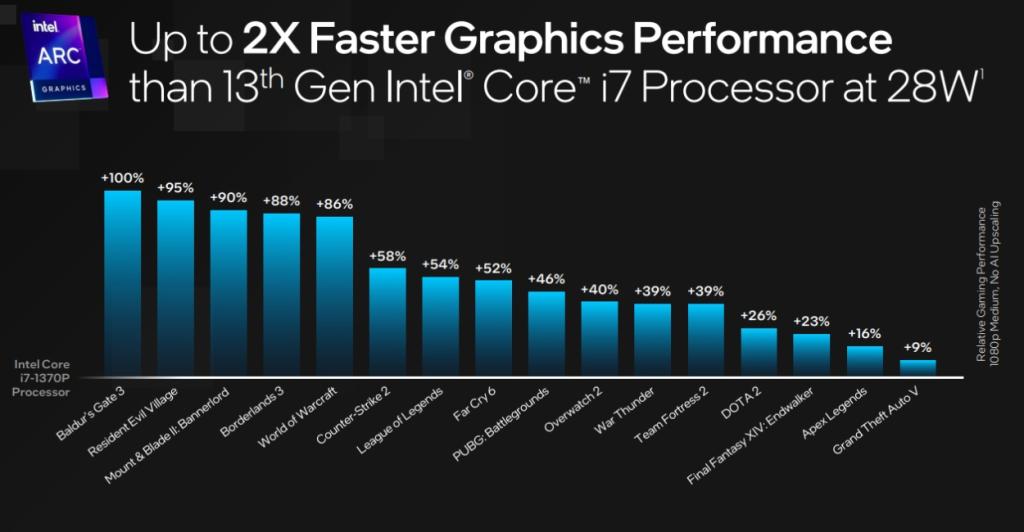
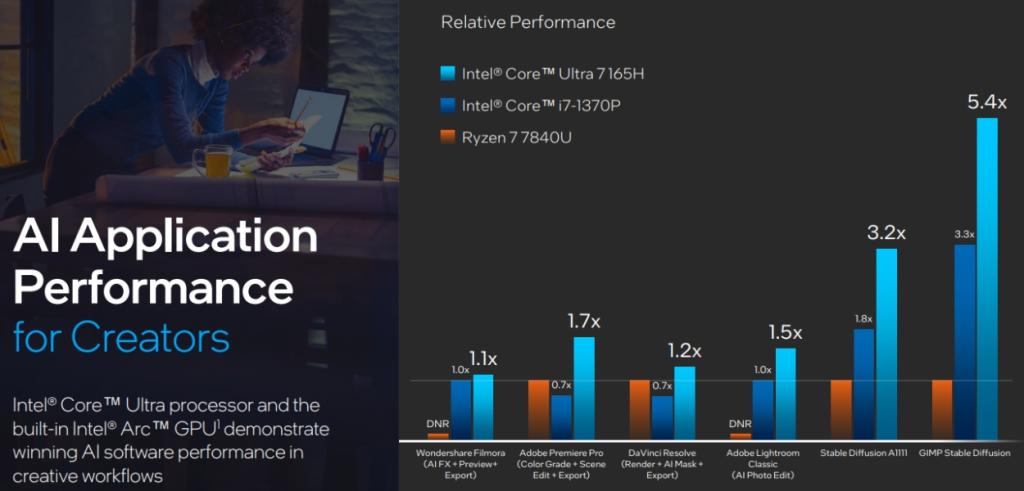
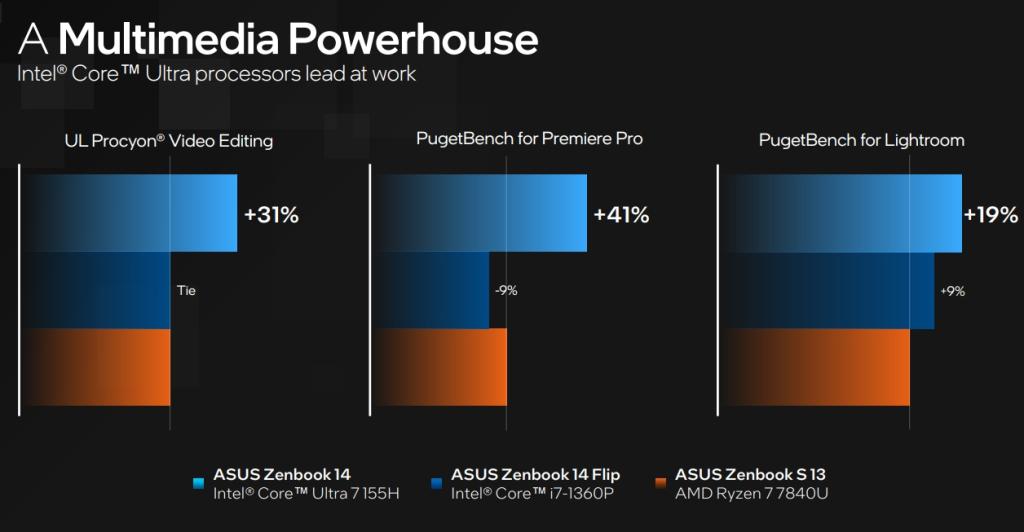
Intel brings major efficiency improvements in the latest architecture. This is why, with the introduction of Meteor Lake, Intel is dropping the ‘i’ from the processor naming scheme. With Intel’s rebranding, new processors will be called Intel Core Ultra for the higher-end ones or simply Intel Core for base variants.
According to the company, Intel Meteor Lake (Core Ultra 7 165H) consumes up to 79% lower power compared to AMD Zen 4 (Ryzen 7 7840U) at 28W. The AMD processor is built on TSMC’s 4nm manufacturing process, so it looks like 14th Gen Meteor Lake CPUs with Intel 4 manufacturing process will feature even better power efficiency!
What’s New in Intel 14th Gen Meteor Lake CPUs?
With Intel’s 14th Gen, the company finally brings forward its Intel 4 process. The latest architecture features EUV lithography, 20% increased power efficiency, and delivers Intel’s new vision of a 3D Performance Hybrid Architecture. A lot has been promised with Intel’s latest 14th Gen Meteor Lake architecture.
AI is a major focus for new Intel processors. On-board Meteor Lake architecture, there lies a new NPU chip that can even be seen in the Task Manager. This is essentially a mini powerhouse purpose-built for AI tasks on your Windows PC. You can even perform offline AI processing with it! Overall, the entire chip is purpose-built for AI. Intel is touting Meteor Lake as having ‘three AI engines’.
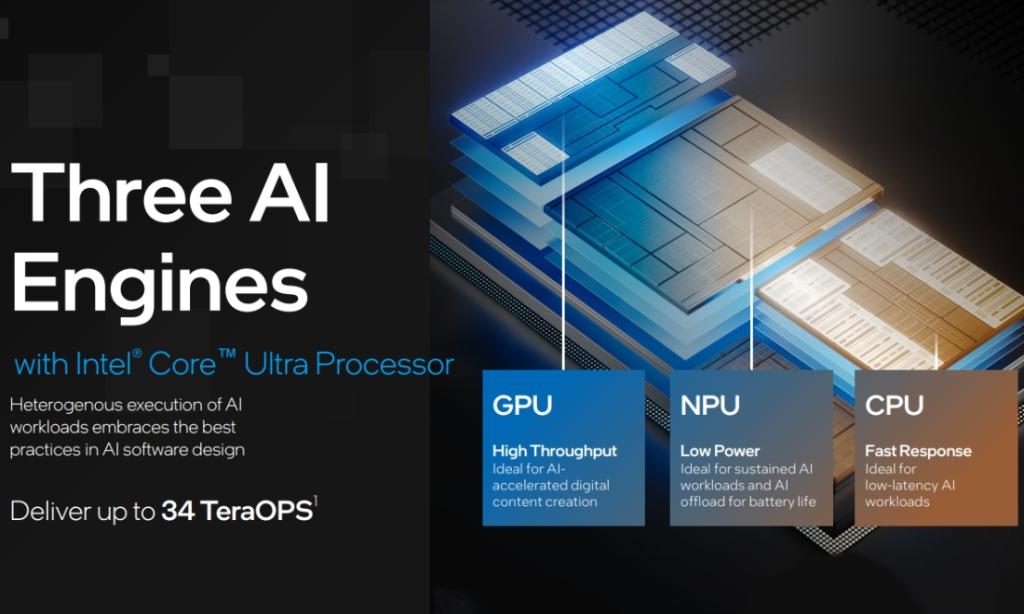
On the software side, the scheduling (allocation of CPU cores to the ongoing tasks) has been improved significantly. Intel Thread Director feeds the operating system with constant feedback, resulting in optimized decision-making when it comes to scheduling. Then, on the hardware side, Intel has introduced a highly dynamic architecture and has introduced a new type of core called Low Power Island (LP E-cores).
This LP E-core lies in the SoC tile of Intel 14th Gen, separate from the compute tile, which contains the main P-Cores & E-Cores. This new LP E-core will handle background tasks and can even handle tasks like video playback while basically sipping power. Intel 14th Gen laptops with Meteor Architecture will perform quite efficiently thanks to the addition of this new core type.
The correct allocation of cores, respective to the task at hand, is all managed by the CPU & OS automatically. According to Intel, during Netflix video playback, the 14th Gen Core Ultra 7 165H consumes 1150mW (1.15W). Comparing this to the previous 13th Gen (i7-1370P), that CPU consumes 1540mW (1.54W) in the same task.
Talking about the new compute tile, it features new Redwood Cove (P–cores) and Crestmont (E-cores). The new P-Cores receive dramatic improvements in terms of performance-per-watt. The new E-Cores now feature VNNI acceleration.
With this, the E-Cores boost AI workloads by accelerating the VNNI (Vector Neural Network Instruction) instruction set, which is used for machine learning & artificial intelligence inference.
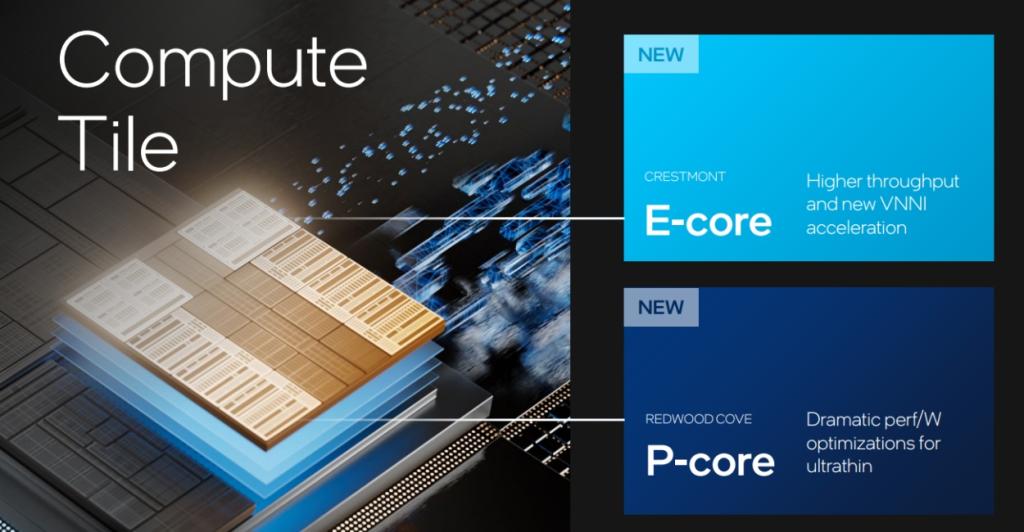
On the connectivity side of things, Intel is dramatically upgrading things here, too. Intel 14th, Gen Meteor Lake, brings WiFi 7 support. 5 Gig networking is now a thing, thanks to this! By the way, AI is truly everywhere on new processors because Intel will include connection optimization software powered by AI.
Plus, Intel Bluetooth 5.4 is also coming to these latest processors. The newest Bluetooth features include LE audio (low power & high-quality sound), multi-stream features, and accessibility enhancements for PC users with hearing impairments. Thunderbolt 4 is also present, the same as the last gen processors. Maybe with 15th Gen, we’ll get to see Thunderbolt 5!
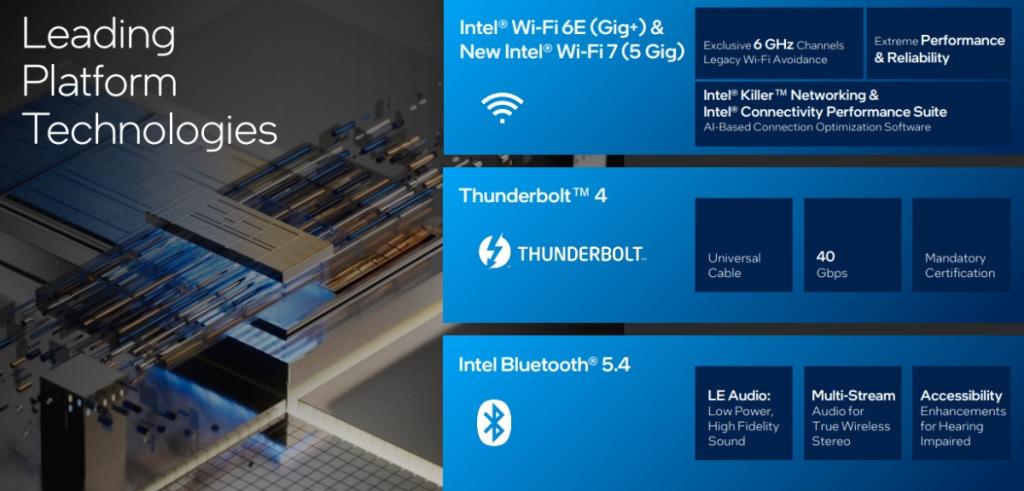
It has been a long time since Intel changed the core manufacturing process of its processors. The previous CPU architectures, known as Alder Lake (12th Gen) & Raptor Lake (13th Gen), were based on the Intel 7 process.
Intel 7 by itself was based on 10nm – which was used in previous processors. Intel did improve upon the CPU efficiency with every generation, but in some cases, the efficiency gains were minimal at best. Now, with Meteor Lake and Intel 4 process, Intel CPUs can be considered to finally be on-par or even better than other chips built on 4nm/5nm manufacturing process.
